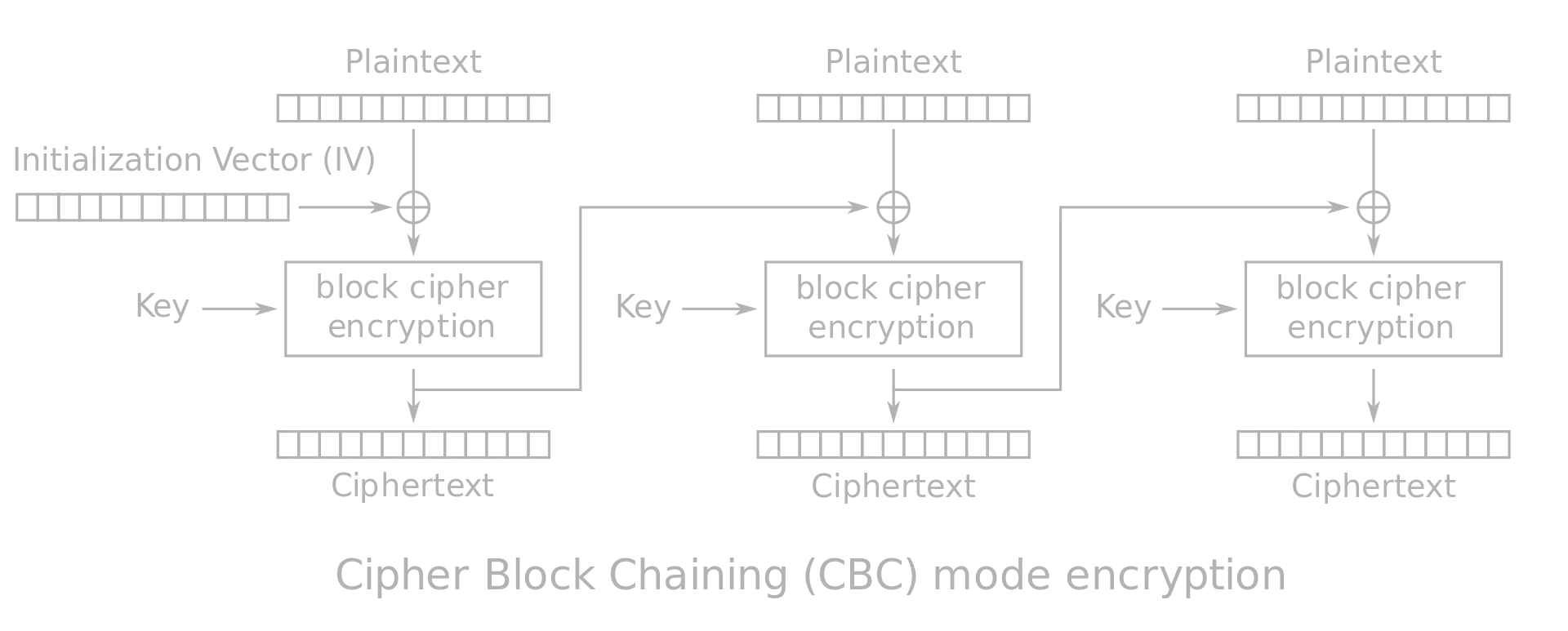AESWCM
5 minutes to read
We got the Python source code of the server:
from Crypto.Util.Padding import pad
from Crypto.Cipher import AES
import os
import random
from secret import FLAG
KEY = os.urandom(16)
IV = os.urandom(16)
class AESWCM:
def __init__(self, key):
self.key = key
self.cipher = AES.new(self.key, AES.MODE_ECB)
self.BLOCK_SIZE = 16
def pad(self, pt):
if len(pt) % self.BLOCK_SIZE != 0:
pt = pad(pt, self.BLOCK_SIZE)
return pt
def blockify(self, message):
return [
message[i:i + self.BLOCK_SIZE]
for i in range(0, len(message), self.BLOCK_SIZE)
]
def xor(self, a, b):
return bytes([aa ^ bb for aa, bb in zip(a, b)])
def encrypt(self, pt, iv):
blocks = self.blockify(pt)
xor_block = iv
ct = []
for block in blocks:
ct_block = self.cipher.encrypt(self.xor(block, xor_block))
xor_block = self.xor(block, ct_block)
ct.append(ct_block)
return b"".join(ct).hex()
def decrypt(self, ct, iv):
ct = bytes.fromhex(ct)
blocks = self.blockify(ct)
xor_block = iv
pt = []
for block in blocks:
pt_block = self.xor(self.cipher.decrypt(block), xor_block)
xor_block = self.xor(block, pt_block)
pt.append(pt_block)
return b"".join(pt)
def tag(self, pt, iv=os.urandom(16)):
blocks = self.blockify(bytes.fromhex(self.encrypt(pt, iv)))
random.shuffle(blocks)
ct = blocks[0]
for i in range(1, len(blocks)):
ct = self.xor(blocks[i], ct)
return ct.hex()
def main():
aes = AESWCM(KEY)
tags = []
properties = []
print("What properties should your magic wand have?")
message = "Property: "
counter = 0
while counter < 3:
property = bytes.fromhex(input(message))
property = aes.pad(message.encode() + property)
if property not in properties:
properties.append(property)
property_tag = aes.tag(property, IV)
tags.append(property_tag)
print(property_tag)
if len(tags) > len(set(tags)):
print(FLAG)
counter += 1
else:
print("Only different properties are allowed!")
exit(1)
if __name__ == "__main__":
main()
Source code analysis
First of all, the program initializes KEY and IV variables to 16 random bytes. After that, an instance of AESWCM class is created.
Then, we are asked to enter a message that will be tagged. Our message (property) will be appended to the messages list (properties). And the tag (property_tag) will be appended to the tags list (tags).
We will see the flag when len(tags) > len(set(tags)); that is, when there is a repeated element in tags (because there are no duplicated elements in a set).
The code below reflects the above explanation:
message = "Property: "
counter = 0
while counter < 3:
property = bytes.fromhex(input(message))
property = aes.pad(message.encode() + property)
if property not in properties:
properties.append(property)
property_tag = aes.tag(property, IV)
tags.append(property_tag)
print(property_tag)
if len(tags) > len(set(tags)):
print(FLAG)
counter += 1
else:
print("Only different properties are allowed!")
exit(1)
Analyzing the encryption algorithm
The way of tagging a message (property) is by calling the tag method (that is "Property: " plus our input data).
This is the tag method:
def tag(self, pt, iv=os.urandom(16)):
blocks = self.blockify(bytes.fromhex(self.encrypt(pt, iv)))
random.shuffle(blocks)
ct = blocks[0]
for i in range(1, len(blocks)):
ct = self.xor(blocks[i], ct)
return ct.hex()
What it does is: it encrypts the plaintext using method encrypt, splits the result in blocks of 16 bytes using blockify and finally, it shuffles the blocks and applies XOR to all of them.
Here we can see that the shuffle is useless, because XOR is commutative, the order does not matter.
Use of AES and XOR
The method encrypt is this one:
def encrypt(self, pt, iv):
blocks = self.blockify(pt)
xor_block = iv
ct = []
for block in blocks:
ct_block = self.cipher.encrypt(self.xor(block, xor_block))
xor_block = self.xor(block, ct_block)
ct.append(ct_block)
return b"".join(ct).hex()
Basically, the plaintext is divided into 16-byte blocks and does the encryption. Let’s recall that the cipher is AES ECB:
class AESWCM:
def __init__(self, key):
self.key = key
self.cipher = AES.new(self.key, AES.MODE_ECB)
self.BLOCK_SIZE = 16
However, the encrypt function is rather similar to AES CBC mode, but not exactly the same. Below, you can see how is AES CBC encryption:

This time, the feedbacks from each block to the next are not the ciphertext blocks, but a XOR between the ciphertext blocks with the plaintext blocks. Say we have 3 plaintext blocks (
Solution
For the solution we are going to avoid padding entering messages sized a multiple of 16 bytes. Let
For the first round we will enter a single block, and we will have
.
Then we will set:
So
.
Notice that
Then we can simplify
Finally, we will set
Then we have
Notice that
On the other hand,
Then we will have
Since
Implementation in Python
def main():
io = get_process()
p_1_1 = b'Property: ' + bytes.fromhex('00' * 6)
io.sendlineafter(b'Property: ', p_1_1[10:].hex().encode())
e_1 = c_1_1 = bytes.fromhex(io.recvline().decode())
p_2_1 = p_1_1
p_2_2 = xor(e_1, p_1_1)
io.sendlineafter(b'Property: ', (p_2_1 + p_2_2)[10:].hex().encode())
e_2 = bytes.fromhex(io.recvline().decode())
c_2_1 = c_1_1
c_2_2 = xor(e_2, c_2_1)
p_3_1 = p_2_1
p_3_2 = p_2_2
p_3_3 = xor(p_2_2, c_2_2)
io.sendlineafter(b'Property: ', (p_3_1 + p_3_2 + p_3_3)[10:].hex().encode())
io.recvline()
log.success(f'Flag: {io.recvline()}')
io.close()
$ python3 solve.py 178.62.21.211:32535
[+] Opening connection to 178.62.21.211 on port 32535: Done
[+] Flag: b'HTB{435_cu570m_m0d35_4nd_hm4c_423_fun}'
[*] Closed connection to 178.62.21.211 port 32535
The full script can be found in here: solve.py.